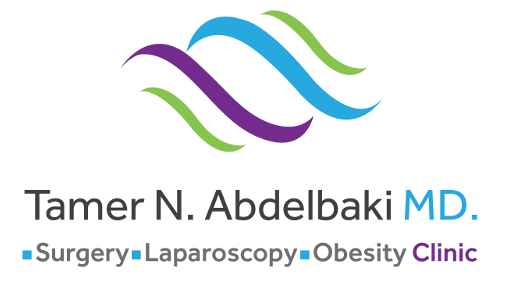Bariatric Surgeries

Sleeve Gastrectomy
Around 80 % of the stomach is removed leaving a banana-shaped pouch. Sleeve gastrectomy helps in achieving weight loss by limiting the size of the stomach and restricting the amount of food consumed. In addition, the procedure limits the secretion of “Ghrelin hormone” (Hunger hormone) therefore reduce the craving for food. Furthermore, the procedure prompts hormonal changes that relieve conditions such as high blood pressure and diabetes.
Advantages:
- Resembles the normal anatomy and physiology of the body. (No Rerouting).
- Limiting amount of food being eaten.
- Hormonal changes reducing appetite and increasing satiety.
- Achieving rapid and sustainable more than 80% excess weight loss. (> 50-60% excess weight loss).
- Remission of diabetes and hypertension.
- Short hospital stay.
Disadvantages:
- Non-reversible procedure.
- Potential long term vitamin deficiency.
- Increase incidence of gastric reflux.

Bikini Line Sleeve Gastrectomy © Dr. Tamer Abdelbaki
Aiming at improving the aesthetic outcome of laparoscopic sleeve gastrectomy, Dr Tamer Abdelbaki developed the Bikini-line Sleeve Gastrectomy in 2016 (aka Bikini Sleeve). It is a new technique involving replacing the 5 abdominal scars used in the standard sleeve by 3 tiny scars hidden in the bikini line and one tiny scar in the belly button resulting in an almost scar-less weight-loss.

images showing the difference of scars between the bikini sleeve and the Standard sleeve


Roux-En Y Gastric Bypass
First, a small stomach pouch, approximately 30 milliliters in volume, is created by dividing the top of the stomach from the rest of the stomach. Next, the first portion of the small intestine is divided, and the bottom end of the divided small intestine is brought up and connected to the newly created small stomach pouch. The procedure is completed by connecting the top portion of the divided small intestine to the small intestine further down so that the stomach acids and digestive enzymes from the bypassed stomach and first portion of the small intestine will eventually mix with the food.
Roux En Y Gastric Bypass achieves weight loss by:
- Restricting size of the stomach and food consumed by creating a small pouch.
- Rerouting of food by connecting the intestine to the new pouch created.
- Malabsorption by bypassing part of the stomach and small intestine thus helping in weight loss.
Advantages:
- Long-term and maintenance 90% excess weight loss.
- Hormonal changes reducing appetite and increasing satiety.
- Remission of diabetes and hypertension.
- Short hospital stay.
- Reversible (despite challenging reversibility techniques).
- Low incidence of gastric reflux when compared to Sleeve Gastrectomy and Mini Gastric bypass (see below).
Disadvantages:
- Technically more complex operation than sleeve gastrectomy.
- Can lead to long-term vitamin/mineral deficiencies particularly deficits in vitamin B12, iron, calcium, and folate.
- Requires adherence to dietary recommendations, life-long vitamin, mineral supplementation, and follow-up compliance.
- Higher incidence for diarrhea and dumping syndrome.

One-Anastomosis Gastric Bypass OAGB / (Mini Gastric bypass MGB)
In this operation a narrow long pouch of the stomach is created (50 ml to 100ml in size).
Then it is connected to a loop of the small intestine, bypassing the first part of the intestine called the duodenum and approximately 150–200cm of the bowel. The rest of the stomach and upper part of the small intestine remains in the body but is no longer used for food digestion.
Advantages:
- Long term and maintenance of > 50-70% excess weight loss.
- Hormonal changes reducing appetite and increasing satiety.
- Remission of diabetes and hypertension.
- Short hospital stay.
- Reversible (despite challenging reversibility techniques).
- Low incidence of gastric reflux when compared to Sleeve Gastrectomy.
Disadvantages:
- Technically more complex operation than sleeve gastrectomy.
- Can lead to long-term vitamin/mineral deficiencies particularly deficits in vitamin B12, iron, calcium, and folate.
- Requires adherence to dietary recommendations, life-long vitamin, mineral supplementation, and follow-up compliance.
- Higher incidence for diarrhea and dumping syndrome.
- Higher incidence for bile reflux.
Mini-Gastric Bypass compared to Roux En Y gastric bypass:
Benefits | Drawbacks |
| One fewer anastomosis (connection of intestines), which in theory means less chance of a complication. | Possibility of severe acid/bile-reflux. Because the pouch is small and the remainder of the stomach is still connected to the intestines. It is possible for gastric juices to travel down the intestines and into the new pouch. |
| Lower complication rate. | |
| Shorter operating time. | |
| Less re-routing of the intestines. Technically easier for the surgeon. | If reflux occurs post-operatively some patients may require acid-suppressing medication. This operation should be avoided for those people with severe symptoms of reflux prior to surgery. |

Revisional Surgeries
Before approval, detailed history of weight loss, appetite control, eating patterns, and adverse outcomes after the primary procedure are mandatory before considering revisional surgery to understand what has gone wrong. Additional workup like upper gastrointestinal endoscopy and radiography are always used before elaborating on a definite treatment plan.
Types of revisional surgeries:
- Re-sleeve Surgery (less favored)
- Sleeve Gastrectomy to Gastric Bypass
- Band removal to Sleeve Gastrectomy
- Band Removal to Gastric Bypass surgery
Revisional surgery is generally more complex and has more complication risks than the primary operation. However, in the hands of skilled and experienced bariatric surgeons, revisional surgery can improve the outcome and reverse failures of primary operations.
Revisional surgery tends to have a longer operation time owing to the complex nature of tasks performed which involves the breakdown of all internal scarring from previous operations. In addition, it might involve the removal of a previously inserted device (gastric band). Finally, owing to the thickening nature of gastric and bowel tissues from previous operations, we, therefore, rely on advanced stapler technology that is designed to staple across such tissues with high precision and safety.
Possible Complications of Bariatric Surgeries:
As with any surgical procedure, the bariatric surgeries have risk profile which is important to understand before proceeding. The following is a comprehensive list of issues which can occur. Most of these complications are very rare and 90–95% of patients have no issues. This list is extensive and is not intended to worry you, but simply inform you about the range of possible complications, regardless of how rare the issue may be. In fact, bariatric surgery has been found to be one of the safest surgeries to undergo. It is considered as safe or more safe when compared to other elective surgeries ( such appendix or gall bladder removal)
Possible early complications:
- Serious complications are those requiring emergency re-operation or any other intervention like endoscopy, transfusion of blood or blood components or mandating stay in the hospital for more than 7 days.
- Leakage. Its incidence is rare. Usually occurs within the first 2 weeks of the operation.
- Postoperative bleeding.
- Other early complications may be: peritonitis; thrombus of deep veins and lung artery; myocardial infarction; pneumonia; abdominal abscess; wound infections; hernias at the surgical site, ulcers.
- 90% of complications that need additional special medical care occur within 48 hours after surgery.
Late complications:
- Stricture or Stenosis of the stomach.
- Ulcers of the stomach.
- Internal hernia (with Gastric Bypass only) – Occasionally the loops of the bowel in the abdomen can become entangled and get stuck. If this occurs, a reoperation is required to fix the problem.
- Adhesions – Any procedure in the abdomen can cause adhesions (scar tissue). This can occur any time after the operation and can sometimes cause problems with the bowel getting stuck or twisted. However, it is still very rare because of the use of minimally invasive surgery which leads to less scarring.
- Gastro-esophageal reflux – If reflux occurs post-operatively some patients may require acid-suppressing medication.
- Dumping syndrome – Dumping syndrome is a group of signs and symptoms that usually occurs due to poor food choices. It is the result of high sugar foods passing too quickly into the small intestine. Symptoms can include cramping, nausea, dizziness, weakness and fatigue. Dietary advice usually helps control the symptoms.
- Malabsorption of vitamins and minerals – Low levels of iron, B12 vitamin and other micronutrients can occur even if recommendations for supplementation are followed. For this reason, regular follow-up visits and blood tests once a year are strongly recommended.
- Risk of malnutrition.
- Gall stones.
Reducing Your Bariatric Surgery Risks
You can help lower some of the risks and possible side effects by:
- Decreasing your weight before the surgery.
- Exercising.
- Stopping smoking.
